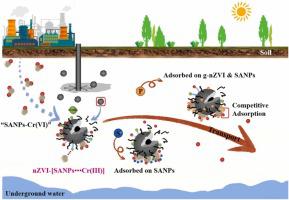Journal of Hazardous Materials ( IF 13.6 ) Pub Date : 2023-05-25 , DOI: 10.1016/j.jhazmat.2023.131716 Yifei Feng 1 , Nan Xu 1 , Lei Peng 1 , Jiayu Shen 1 , Xiangrong Yang 1

|
Remediating hexavalent chromium (Cr(VI))-contaminated soils using green synthesized nano-iron (g-nZVI), which merits high reactivity, low cost, and environmental friendliness, has attracted significant attention. However, the broad existence of nano plastics (NPs) could adsorb Cr(VI) and subsequently influence in situ remediation of Cr(VI)-contaminated soil by g-nZVI. To clarify this issue and improve the remediation efficiency, we investigated the co-transport between Cr(VI) and g-nZVI coexisting with sulfonyl-amino-modified nano plastics (SANPs) in water-saturated sand media in the presence of oxyanions (i.e., phosphate and sulfate) at environmentally relevant conditions. This study found that SANPs inhibited the Cr(VI) reduction to Cr(III) (i.e., Cr2O3) by g-nZVI, attributed to nZVI-SANPs hetero-aggregates and Cr(VI) adsorption on SANPs. Notably, “nZVI-[SANPs•••Cr(III)]” agglomerate happened via complexation of [–NH3•••Cr(III)] between Cr(III) from Cr(VI) reduced by g-nZVI and amino group on SANPs. Further, the co-presence of phosphate (stronger adsorption on SANPs than g-nZVI) remarkably suppressed Cr(VI) reduction. Then, it promoted the co-transport of Cr(VI) with nZVI-SANPs hetero-aggregates, which could potentially threaten underground water. Fundamentally, sulfate would instead concentrate on SANPs, hardly impacting the reactions between Cr(VI) and g-nZVI. Overall, our findings provide crucial insights into understanding the Cr(VI) species transformation during co-transport with g-nZVI in ubiquitous complexed soil environments (i.e., containing oxyanions) contaminated by SANPs.
中文翻译:

纳米塑料在含氧阴离子存在下促进绿色合成纳米铁的运输过程中抑制 Cr(VI) 物种转化
使用绿色合成纳米铁 (g-nZVI) 修复六价铬 (Cr(VI)) 污染的土壤,具有高反应性、低成本和环境友好等优点,受到了广泛关注。然而,广泛存在的纳米塑料 (NPs) 可以吸附 Cr(VI),进而影响g-nZVI 对 Cr(VI) 污染土壤的原位修复。为了澄清这个问题并提高修复效率,我们研究了 Cr(VI) 和 g-nZVI 在含氧阴离子(即、磷酸盐和硫酸盐)在环境相关条件下。该研究发现 SANP 抑制 Cr(VI) 还原为 Cr(III)(即 Cr 2 O 3) 通过 g-nZVI,归因于 nZVI-SANPs 杂聚体和 Cr(VI) 在 SANPs 上的吸附。值得注意的是,“nZVI-[SANPs•••Cr(III)]”团聚体通过[–NH 3的络合发生•••Cr(III)] 在由g-nZVI 还原的Cr(VI) 中的Cr(III) 和SANP 上的氨基之间。此外,磷酸盐的共存(比 g-nZVI 对 SANP 的吸附更强)显着抑制了 Cr(VI) 的还原。然后,它促进了 Cr(VI) 与 nZVI-SANPs 异质聚集体的共同运输,这可能会威胁地下水。从根本上说,硫酸盐会集中在 SANPs 上,几乎不影响 Cr(VI) 和 g-nZVI 之间的反应。总的来说,我们的研究结果为理解在普遍存在的被 SANP 污染的复杂土壤环境(即含有氧阴离子)中与 g-nZVI 共运输过程中的 Cr(VI) 物种转化提供了重要见解。



























 京公网安备 11010802027423号
京公网安备 11010802027423号